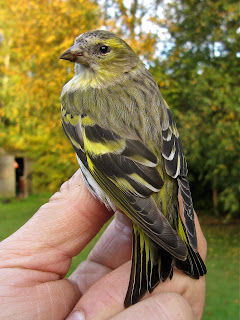Saturday 30th July to Wednesday 03 August was the Wash Wader Ring Group's (WWRG) Mini Wash Week. Two teams were assembled, one for the Lincolnshire side and another covering the Norfolk side of the Wash. Having been assigned to the Norfolk team catching attempts were made at Terrington Marshes, Heacham Beach and Ken Hill near Heacham. Additionally on Sunday afternoon I and several others from the Norfolk team went round to help the Lincolnshire team lug gear out for a cannon net catch of Knot on Wainfleet Island. Having been on a couple of Wash weekends based in Norfolk this gave me the opportunity to experience the Lincolnshire side.
This trip was another great Wash Wader Ringing experience with successful cannon net catches made on several occasions.
Sunday morning two cannon nets were set on Terrington Marsh with a view to catching Curlew. The tide, however, was insufficiently high to push birds onto the saltmarsh. Sunday afternoon saw myself and a few others from the Norfolk team drive round to meet up with the Lincolnshire team to set four nets on Wainfleet Island. All but the hide team remained out of sight under a large piece of covering material waiting for the tide to rise with gulls and terns wheeling overhead. All those assigned a particular task ran to the nets as soon as the 'bang' was heard. The catch was dealt with quickly and birds were soon extracted and waiting in keeping cages while the ringing and processing teams were assembled. In total 108 Knot, 46 Dunlin and 2 Sanderling were caught and processed.
Knot - still in breeding plumage
Adult Dunlin
Monday morning saw us assemble behind the dunes of Heacham South Beach with a view to catching Sanderling using nets set by the rest of the Norfolk team on Sunday night. The catch was successful and once the nets had been lifted, birds extracted and put in keeping cages; ringing and processing teams dealt with 228 Sanderling, 2 Dunlin and singles of Ringed Plover and Turnstone. Having never ringed adult Ringed Plover I was lucky enough to get this opportunity.
Adult Sanderling Adult Ringed Plover
After a tasty lunch provided by Barbara, our amazing cook for the trip, we headed off to Ken Hill where Nigel had seen 200 Curlew on Sundays recce. Four nets were set in a clap net pair and decoys strategically placed in the catching area. Watching from the hide a few birds settled in with the decoys but further birds landed in an adjacent field. Twinkling saw 25 in the catching area and it was decided to make a small catch in order to familiarise the team in dealing with a Curlew catch and reset for Tuesday morning. Twenty birds were caught of which four were retraps. After the catch was processed the fired nets were reset for the next morning.
Long shadows as the ringing and processing teams
deal with Monday evenings small Curlew catch
Tuesday morning saw the hide teams up and leaving for Ken Hill at 05:00. Once in position and all circuit testing complete the Curlew started to arrive steadily but were soon put off by a juvenile Marsh Harrier which took a liking to one of the decoys; the Curlew once again settling in a neighbouring field. Twinkling was performed admirably by John and Jo and a large flock of Curlew and Godwits were soon airborne and drifting over our field with Curlew settling in nicely; the Godwits, however, were destined for another day. Two nets were fired and the resultant catch dealt with very smoothly indeed with 63 Curlew and 2 Bar-tailed Godwit being caught.
Ringing and processing teams were assembled and dealt with the Curlew first. Having never ringed Bar-tailed Godwit I snapped up the opportunity. Both Godwits were also leg-flagged with my bird being given a white flag bearing the letters TJ. The leg flags should make them more easily resighted in the field, removing the need to recapture birds to identify individuals.
The Wash Wader Ringing Group are currently running colour marking projects on Bar-tailed Godwits, Turnstone, Grey Plover and Sanderling.
TJ the Bar-tailed Godwit
After lunch it was decided to explore the options of setting canon nets on the rocks at the back of the bund and a team headed out to construct a crude dry stone wall from which a cannon net could be fired. After an hour or so of hard toil the wall was built and we returned to base for well earned showers.
On Wednesday morning we headed out to the bund with all the equipment shared out between the team before treading the Samphire pickers path out across the salt marsh. A single net was set and base camp members relaxed beneath camouflage netting waiting beneath a beautiful blue sky for the tide to come in. The tide and weather were not in our favour; the sea didn't come in far enough and without any wind to lap waves on to the rocks the few birds that arrived were well out of reach. The net was fired to give the team practice at performing a lift over rocks.
Once everything was packed up the wall was extended to allow two nets to be set and a group photo taken as sadly another Wash trip had come to an end.
WWRG Mini Week 2011


















































